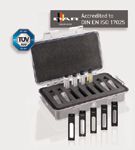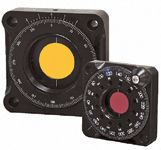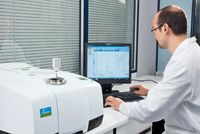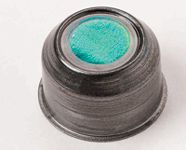Product Resources
Products
Scientific CMOS camera
The Zyla 5.5-megapixel scientific CMOS camera from Andor is designed for research and OEM usage. The camera reportedly provides a 100-fps frame rate, rolling and snapshot shutter modes, and low noise. According to the company, the camera achieves a read noise of as low as 1.2 electron rms and can read out the sensor through a 10-tap camera interface. A 3-tap version is available that reportedly provides up to 30 fps. Andor Technology, South Windsor, CT;

Raman spectrometers
BaySpec's high-throughput f/2 Raman spectrometers feature volume phase gratings that are designed to be customizable to any wavelength range. According to the company, all spectrographs are dispersive nonscanning and all points along the spectrum are obtained simultaneously. Detectors reportedly are optimally cooled to -55 °C for low light sensitivity. BaySpec, Inc., San Jose, CA;

ICP accessory
The Niagara Plus accessory from Glass Expansion is designed to double ICP productivity and reduce carryover and memory. According to the company, the accessory had a 12-port valve that has been replaced with a six-port valve, and a removable seventh port is available for automatic dilution or addition of internal standard. Software and firmware reportedly are preloaded on a Netbook to simplify installation. Glass Expansion, Inc., Pocasset, MA;

Miniature OEM spectrometer
The VS-7000+ Mini CCD spectrometer from Horiba Scientific is designed for UV–vis–NIR OEM applications. The spectrometer features a back-thinned CCD with a deep full well, two height options, and a USB 2.0 interface. According to the company, the spectrometer can be used for industrial low-light applications such as fluorescence, emission, absorbance, and reflectance measurements. The spectrometer's single-optic design with a concave grating reportedly includes no moving parts or shutter. Horiba Scientific, Edison, NJ;

Miniature CCD spectrometer
B&W Tek's Exemplar miniature spectrometer includes an embedded processor for on-board data processing, with functions such as averaging, smoothing, and automatic dark subtraction. The CCD spectrometer is designed with USB 3.0 communication for data transfer of 900 spectra/s. Other features reportedly include multichannel capabilities with a trigger delay of 14 ns and a gate jitter of ±1 ns, a 2048-element detector, and a built-in 16-bit digitizer with a >2.0 MHz readout speed. B&W Tek, Newark, DE;

Desolvating nebulizer
The CETAC Aridus II desolvating nebulizer system is designed to improve sensitivity up to 10-fold for all types of ICP-MS instruments. According to the company, the nebulizer system provides low oxide (CeO/Ce < 0.03%) and hydride levels. The system reportedly is equipped with the company's C-Flow PFA concentric nebulizer with flow rates of 50, 100, and 200 μL/min. CETAC Technologies, Omaha, NE;

Calibration standards
Hellma's calibration standards for spectrophotometers include liquid secondary standards for instrument calibration according to national and international standards. According to the company, the liquid filters are made with high-purity calibration solutions sealed in Suprasil quartz cells with a 10-mm light path. The calibration standards reportedly are available individually and in sets. Hellma USA, Inc., Plainview, NY;

Instrument guide
OI Analytical's Product Solutions Guide reportedly contains information about laboratory and on-line instruments for solving chemical analysis problems in science and industry. OI Analytical, College Station, TX;

Wire grid polarizers
Ruled and holographic wire grid polarizers from Optometrics are designed to polarize radiation from an unpolarized molecular laser, attenuate radiation from a polarized laser, or, using two in series, both polarize and attenuate a laser beam. According to the company, they can also be used in reflectance accessories for dispersive and FT-IR spectrometers. Applications include the investigation of metal surfaces and crystal structures at grazing incidence. Optometrics Corp., Ayer, MA;

Microvolume UV spectrophotometer
Shimadzu's BioSpec-nano spectrophotometer is designed for fast, reproducible concentration determination of nucleic acids and proteins. The instrument reportedly requires a sample volume of 1 μL (0.2-mm pathlength) or 2 μL (0.7-mm pathlength), which is pipetted onto its measurement plate. No standard rectangular cell is needed, although a rectangular cell adapter is available. According to the company, sample mounting, measurement, and cleaning are performed automatically by the instrument, and measurement time is 3 s. Shimadzu Scientific Instruments, Columbia, MD;

UV–vis spectrophotometers
Thermo Fisher Scientific's Evolution 200 Series UV–vis spectrophotometers can be used for applications ranging from standard quantitative analysis to research life science assays. The spectrophotometers reportedly feature the company's Insight software with Cue scripting capabilities. According to the company, the instruments are designed for routine QA/QC analyses in the life science, food and beverage, and pharmaceutical industries. Thermo Fisher Scientific, Waltham, MA; www.thermoscientific.com

ICP-MS system
PerkinElmer's NexION 300 ICP-MS system is designed to provide the benefits of a collision cell and the detection limits of a true reaction cell. According to the company, the instrument can be run in three different modes: standard, collision, and reaction. A scanning quadrupole reportedly removes targeted interferences and reaction products in the universal cell. PerkinElmer, Waltham, MA;

GC–FT-IR interface
A GC–FT-IR interface accessory from Pike Technologies is designed to merge the separation capability of gas chromatography with the identification capability of IR analysis. The accessory includes heated transfer lines, a heated gas cell, and an on-board MCT detector enclosed in a purgeable external module. Applications include the analysis of crude oils and petrochemical processes and products; the study of pesticides, insecticides, and fungicides; and fragrance and essential oil analysis for fingerprinting chemicals. PIKE Technologies, Madison, WI;

ICP-MS standards
Single-element 1-ppm standards from Spex CertiPrep are intended for use in ICP-MS analysis. The company reportedly is accredited by UL DQS for ISO 9001 and by A2LA for ISO 17025 and ISO Guide 34. Spex CertiPrep, Metuchen, NJ;

Microwave digestion system
The Ethos EZ closed-vessel microwave digestion system from Milestone features a proportional integral derivative (PID) controller that is designed to apply the correct amount of microwave power in every situation. According to the company, users do not need to enter information such as vessel type, number of vessels, or sample weight before starting a digestion. The controller reportedly measures digestion temperature 20 times/s. The system is encased in a stainless steel cabinet, and a pressure-release door reportedly reseals instantly in the case of overpressure caused by a vessel failure. Milestone, Inc., Shelton, CT;

FT-IR microscope
The Lumos stand-alone FT-IR microscope from Bruker Optics is designed for visible inspection and infrared spectral analysis. According to the company, all internal moveable components are motorized and the instrument's software guides operate stepwise through the process of data acquisition. Bruker Optics, Billerica, MA;
www.brukeroptics.com/lumos.html

ICP-MS system
The Agilent 8800 triple-quadrupole ICP-MS system is designed to provide improved performance compared with single-quadrupole ICP-MS and to provide MS-MS operation for interference removal in reaction mode. According to the company, the system can be used to analyze elements in life-science, soil, rock, and plant materials. The system reportedly also can be set up to operate like a single-quadrupole ICP-MS system. Agilent Technologies, Santa Clara, CA;

Automated circular dichroism spectrometer
The Chirascan-plus ACD spectrometer from Applied Photophysics is designed to provide flexible, robust automation and simultaneous measurement of circular dichroism and absorbance. According to the company, the spectrometer's software provides automation control, application development, and integrated spectroscopic analysis tools. Applied Photophysics Ltd., Leatherhead, UK;

Infrared spectrometer
PerkinElmer's Frontier FT-IR spectrometer is designed as a modular and upgradeable platform for near-, mid-, and far-infrared spectroscopic analysis of samples such as polymers, chemicals, consumer goods, and pharmaceuticals. According to the company, the instrument's automated range changing capability allows the use of multiple techniques, and its optical system allows the addition of microscopy and imaging systems for detailed materials analysis. PerkinElmer, Inc., Seer Green, United Kingdom;

Handheld Raman analyzer
The Xantus-2 dual-wavelength handheld Raman analyzer from Rigaku Raman Technologies is designed to overcome the fluorescence issues found in many materials. The analyzer operates at 785-nm and 1064-nm wavelengths. According to the company, the analyzer is suited for chemical identification of materials such as narcotics and illicit street drugs, explosives and chemical warfare agents, pharmaceuticals, hazardous materials and chemical spills, and incoming raw materials. Rigaku Raman Technologies, Inc., San Jose, CA;

XRF kit
Amptek's XRF Kit is designed to help users begin performing elemental analysis via X-ray fluorescence. According to the company, the kit includes the company's X-123 complete spectrometer with an SDD or Si-PIN detector; a mini-X USB controlled X-ray tube; XRF-FP QA software; a mounting plate; and a test sample. Amptek Inc., Bedford, MA;

Spectrometer
The AvaSpec-ULS2048XL spectrometer from Avantes is designed to combine the quantum efficiency of a back-thinned CCD detector with the electronic control required for high-speed applications such as LIBS and pulsed light source measurements. According to the company, the instruments' detector has 2048 pixels, each measuring 14 ? 500 μm. Avantes, Broomfield, CO;

Benchtop WDXRF spectrometer
The Supermini benchtop wavelength dispersive X-ray fluorescence spectrometer system from Rigaku Americas Corporation is designed for high sensitivity, nondestructive analysis of elements ranging from fluorine through uranium in solids, liquids, powders, and thin films. According to the company, the instrument includes three analyzing crystals; two detectors; a 12-position sample changer; a 50-kV, 200-W tube; and a choice of analysis in an air, vacuum, or helium atmosphere. Rigaku Americas Corporation, The Woodlands, TX;

FT-IR spectrometer
The Thermo Scientific Nicolet iS50 FT-IR spectrometer is designed for one-touch operation in research applications such as the analysis of polymers and rubbers, forensics, pharmaceuticals, pigments and paints, and foods and flavors. The spectrometer can be equipped with optional ATR, Raman, and NIR modules. According to the company, the instrument features three detectors for the main sample compartment, a collimated or focused emission port, and a base footprint of 25 X 27 X 11 in. Thermo Fisher Scientific, Waltham, MA; www.thermoscientific.com/iS50

Raman analyzer
The ASSUR handheld Raman analyzer for raw material verification from Enwave Optronics is designed to be fully 21 CFR Part 11 compliant for GMP requirements. According to the company, it is suitable for the analysis of pharmaceutical compounds and industrial chemicals and for applications requiring high-speed Raman analysis. Enwave Optronics, Inc., Irvine, CA; www.enwaveopt.com

Hyperspectral imaging system
The HI 90 hyperspectral imaging system from Bruker Optics is designed as a remote chemical sensing system that permits detection, identification, and quantification of hazardous gas clouds. According to the company, the system allows remote operation several kilometers from the area of interest. Bruker Optics, Billerica, MA; www.brukeroptics.com

Fiber-optic Raman probes
FiberTech Optica's compact fiber-optic Raman probes are designed to provide enhanced throughput and collected Raman signal quality. According to the company, design features include high collection efficiency (f/2) optics, internal filtering, about 4 mm working distance, and assembly with no moving parts. FiberTech Optica, Kitchener, Ontario, Canada; www.fibertech-optica.com

Spark atomic emission spectrometer
The OBLF GS 1000-II spark atomic emission spectrometer from PANalytical includes a spark stand design that incorporates two counter electrodes. The design reportedly reduces total analysis time versus single-electrode spectrometers. According to the company, the instrument is capable of performing a two-measurement analysis of ferrous samples in 25 s. Samples requiring only standard carbon analysis and no nitrogen reportedly have an analysis time of 15 s. PANalytical, Westborough, MA;

Spectrometer
StellarNet's Black-Comet-HR concave grating spectrometer is designed for high-resolution applications. According to the company, the system is available for measurements in two ranges, UV (200–600 nm) and visible (380–750 nm), and can achieve resolving resolutions of 0.4 nm. The system reportedly is USB-2 powered, shock-proof, and vibration tolerant with no moving parts StellarNet, Tampa, FL;

Raman software
LabSpec 6 Raman software from Horiba Scientific is designed to guide researchers through system setup, Raman spectrum data and map acquisition, measurement and data processing, and report generation. The software reportedly offers comprehensive data acquisition, processing, and display functionalities for the company's Raman, cathodoluminescence, and photoluminescence spectrometers. According to the company, the software also includes an integrated multivariate analysis module for characterization of complex datasets and on-the-fly data processing. Horiba Scientific, Edison, NJ;

X-ray windows
DuraBeryllium X-ray windows from Moxtek are designed to be resistant to many solvents, acids, and bases. The company's DuraBeryllium Plus film reportedly provides maximum corrosion resistance. According to the company, the product is a low-Z material that when applied to beryllium creates a hermetic, corrosion-resistant window that is used for ultrahigh-vacuum applications. Moxtek, Orem, UT;

Variable-pathlength FT-IR cell
International Crystal's heated variable-pathlength cell is designed with the ability to be heated to 200 °C and comes with a programmable temperature controller with a RS-232 serial cable computer interface. According to the company, the cell back plate is water-cooled, and the body and vernier scale adjustment on the front of the cell are insulated to enable in situ variation of the pathlength while the cell is situated in the sample compartment of an FT-IR spectrophotometer. International Crystal Laboratories, Garfield, NJ; www.internationalcrystal.net


High-Speed Laser MS for Precise, Prep-Free Environmental Particle Tracking
April 21st 2025Scientists at Oak Ridge National Laboratory have demonstrated that a fast, laser-based mass spectrometry method—LA-ICP-TOF-MS—can accurately detect and identify airborne environmental particles, including toxic metal particles like ruthenium, without the need for complex sample preparation. The work offers a breakthrough in rapid, high-resolution analysis of environmental pollutants.
Karl Norris: A Pioneer in Optical Measurements and Near-Infrared Spectroscopy, Part II
April 21st 2025In this two-part "Icons of Spectroscopy" column, executive editor Jerome Workman Jr. details how Karl H. Norris has impacted the analysis of food, agricultural products, and pharmaceuticals over six decades. His pioneering work in optical analysis methods including his development and refinement of near-infrared spectroscopy, has transformed analysis technology. In this Part II article of a two-part series, we summarize Norris’ foundational publications in NIR, his patents, achievements, and legacy.